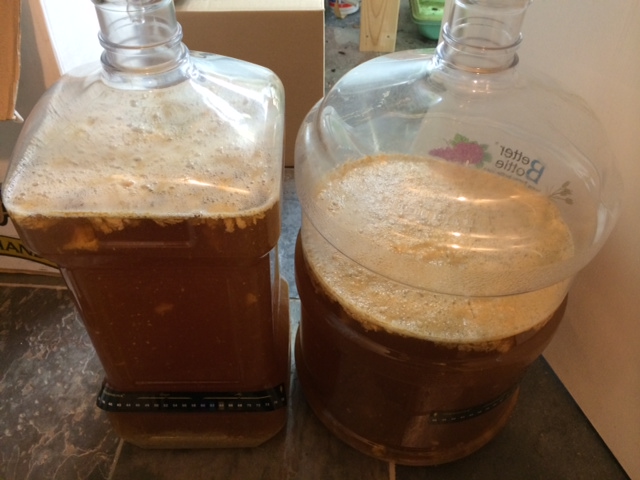marvaden
Well-Known Member
Right now I am starting to plan to make a unique beer using a wine yeast and brettanomyces pitched at the same time. I am in no rush to start this since I will be moving in a few months to a new house, but I am looking for some input.
Since this is going to take a while to ferment, I believe that I am going to jump straight in with an amber/brown ale. The desired flavor profile will be fruity, slight-if-any funk, silky body, a fair amount of malt character without overpowering the fruit/spice, and low to medium spice.
Wine Yeast Candidates:
- Wyeast Bordeaux
-- Berry esters with a graham cracker nose
-- Jammy, thick mouthfeel. This is because of saccharides that are produced by this yeast
- Wyeast Chablis
-- Lots of esters (but I don't see a description of which ones) with a bready/vanilla nose. It also allows the fruit to dominate, so this may be a bit of a clean wine yeast
-- Soft mouthfeel
- WLP727 Steinberg-Geisenheim
-- High fruit/ester production
- WLP749 Assmanshausen
-- High fruit and spice aroma
-Brettanomyces Candidates:
-- Wyeast Brettanomyces Lambicus (single)
-- White Labs Brettanomyces Bruxellensis Trois (single)
-- White Labs Brettanomyces Claussenii (single)
-- Wyeast Brett L + White Labs Brett C blend
-- Wyeast Brett L + White Labs Brett B Trois blend
Grain bill options (20lb total):
1. 75% Vienna, 20% Pilsner, 5% Special B
2. 75% Vienna, 20% Pilsner, 2.5% Biscuit, 2.5% Special B
3. 75% Vienna, 20% Pilsner, 5% CaraMalt
4. 75% Munich, 20% Pilsner, 5% Special B
5. 75% Munich, 20% Pilsner, 2.5% Biscuit, 2.5% Special B
6. 75% Munich, 20% Pilsner, 5% CaraMalt
Hops options (will adjust quantities to get ~25IBU):
1. Cascade only
2. Bitter with Cascade, flameout with Fuggle
3. Bitter with Cascade, flameout with Fuggle and Mt Hood
4. Bitter with Cascade, flameout with Fuggle and Mt Hood and Cascade
5. Bitter with Fuggle, flameout with Fuggle and Mt Hood
6. Bitter with Fuggle, flameout with Cascade and Mt Hood and Fuggle
I do not know if the wine yeast will produce enough phenols and diacetyl to lend to the normal brett character. I believe that the Brett L should still produce it's usual cherry flavor, though. Just like the two White Labs strains should produce their pineapple/mango flavors.
Since I enjoy hops, I do want a bit of their flavor to come through in the final product. However, I more want them to add to complexity rather than to be the focus.
I will kick this off in April, so we can argue recipe for a while .
.
Cheers!
Since this is going to take a while to ferment, I believe that I am going to jump straight in with an amber/brown ale. The desired flavor profile will be fruity, slight-if-any funk, silky body, a fair amount of malt character without overpowering the fruit/spice, and low to medium spice.
Wine Yeast Candidates:
- Wyeast Bordeaux
-- Berry esters with a graham cracker nose
-- Jammy, thick mouthfeel. This is because of saccharides that are produced by this yeast
- Wyeast Chablis
-- Lots of esters (but I don't see a description of which ones) with a bready/vanilla nose. It also allows the fruit to dominate, so this may be a bit of a clean wine yeast
-- Soft mouthfeel
- WLP727 Steinberg-Geisenheim
-- High fruit/ester production
- WLP749 Assmanshausen
-- High fruit and spice aroma
-Brettanomyces Candidates:
-- Wyeast Brettanomyces Lambicus (single)
-- White Labs Brettanomyces Bruxellensis Trois (single)
-- White Labs Brettanomyces Claussenii (single)
-- Wyeast Brett L + White Labs Brett C blend
-- Wyeast Brett L + White Labs Brett B Trois blend
Grain bill options (20lb total):
1. 75% Vienna, 20% Pilsner, 5% Special B
2. 75% Vienna, 20% Pilsner, 2.5% Biscuit, 2.5% Special B
3. 75% Vienna, 20% Pilsner, 5% CaraMalt
4. 75% Munich, 20% Pilsner, 5% Special B
5. 75% Munich, 20% Pilsner, 2.5% Biscuit, 2.5% Special B
6. 75% Munich, 20% Pilsner, 5% CaraMalt
Hops options (will adjust quantities to get ~25IBU):
1. Cascade only
2. Bitter with Cascade, flameout with Fuggle
3. Bitter with Cascade, flameout with Fuggle and Mt Hood
4. Bitter with Cascade, flameout with Fuggle and Mt Hood and Cascade
5. Bitter with Fuggle, flameout with Fuggle and Mt Hood
6. Bitter with Fuggle, flameout with Cascade and Mt Hood and Fuggle
I do not know if the wine yeast will produce enough phenols and diacetyl to lend to the normal brett character. I believe that the Brett L should still produce it's usual cherry flavor, though. Just like the two White Labs strains should produce their pineapple/mango flavors.
Since I enjoy hops, I do want a bit of their flavor to come through in the final product. However, I more want them to add to complexity rather than to be the focus.
I will kick this off in April, so we can argue recipe for a while
 .
. Cheers!




